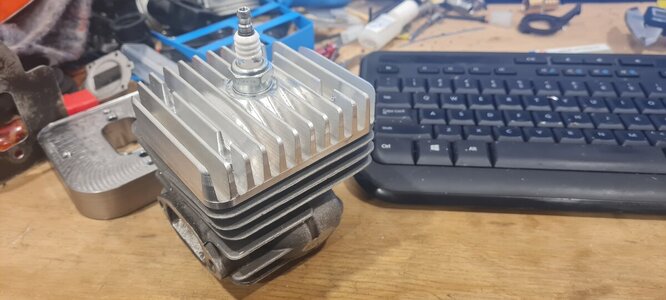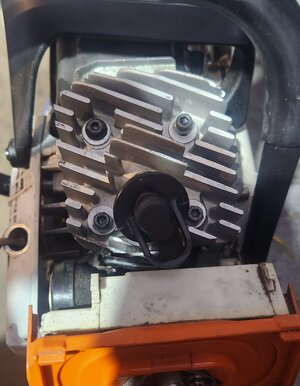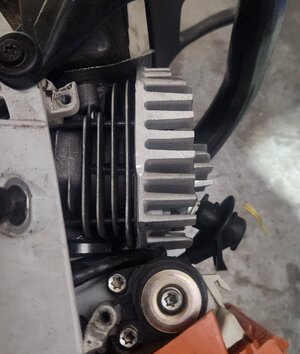Darryll
Well-Known OPE Member
- Local time
- 11:10 PM
- User ID
- 1886
- Joined
- Sep 23, 2016
- Messages
- 73
- Reaction score
- 132
- Location
- New Zealand
Of late I have been playing around with cylinder heads on my 372 and CNC machining them with cooling fins and sealing them with FKM O rings and torture testing it. Almost surprisingly the saw never got hot after several tank's of back back cutting with a 36" buried into wood. So I'm quietly hoping this may help me unlock a bit more potential reliably. It was a 52mm Hyway and pretty conservative numbers and the saw had an awesome spread of power, certainly better than anything I have built before. It felt very aggressive to run and handled the 36" better than my stock 592. As a side note to be able to remove the head about as quick as pulling the plug has been great for monitoring. Thanks to the modern Marvels of todays world I can design the head with a given compression ratio and machine it rather precisely. For the record 10.5:1 is too much. Even with the plug centered and a tight squish it rattled its self almost to death with 91 fuel, I don't want the hassle of having 98 on site. I think somewhere around 10:1 is the sweet spot. If I lived in the states I'd probably reach out to Dyno Joe to test it for me.
I've also been playing with lengthening the intake track and running the 660 carb on it. This absolutely picked up a fair bit in the very top end responding a bit like a powerband. Certainly some sort of resonance going on. It would be nice if it was a few thousand revs lower but I'll take that as a win for now. I have put a fair bit of work into this so far and started to get some real results. There is a fair bit left to get this sorted but once I get the air filter etc worked out and 3D printed I think there is some potential there to be had. The goal here is to build myself a 9-10+ hp 372 that can be used everyday.
I'd also like to make my own piston. If anyone has already been down that road I like to here about it.
I've also been playing with lengthening the intake track and running the 660 carb on it. This absolutely picked up a fair bit in the very top end responding a bit like a powerband. Certainly some sort of resonance going on. It would be nice if it was a few thousand revs lower but I'll take that as a win for now. I have put a fair bit of work into this so far and started to get some real results. There is a fair bit left to get this sorted but once I get the air filter etc worked out and 3D printed I think there is some potential there to be had. The goal here is to build myself a 9-10+ hp 372 that can be used everyday.
I'd also like to make my own piston. If anyone has already been down that road I like to here about it.
Attachments
Last edited:









